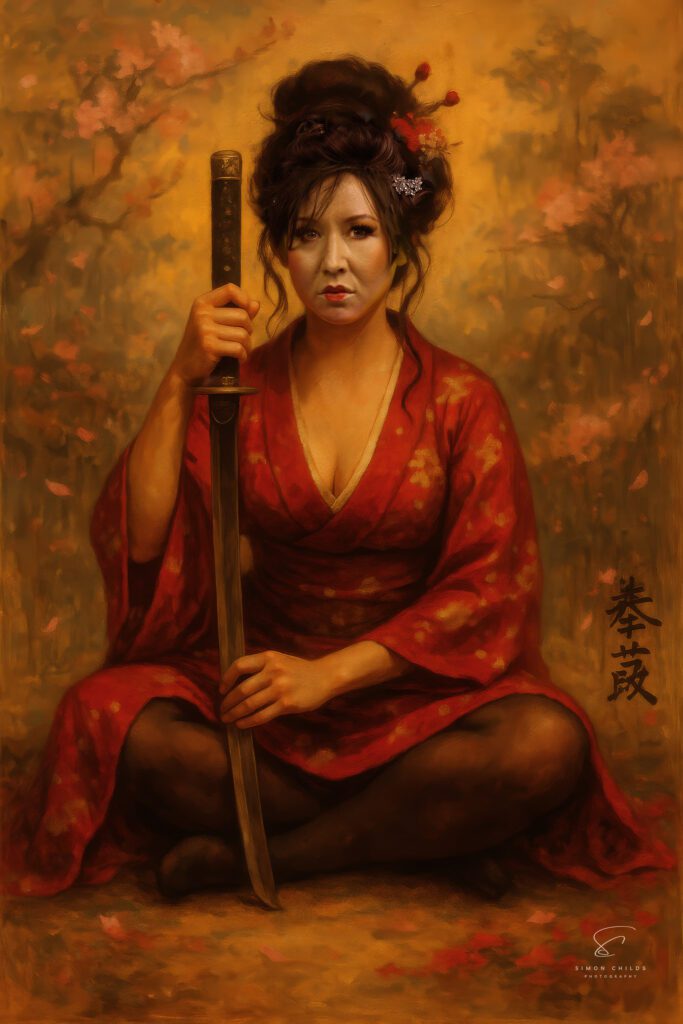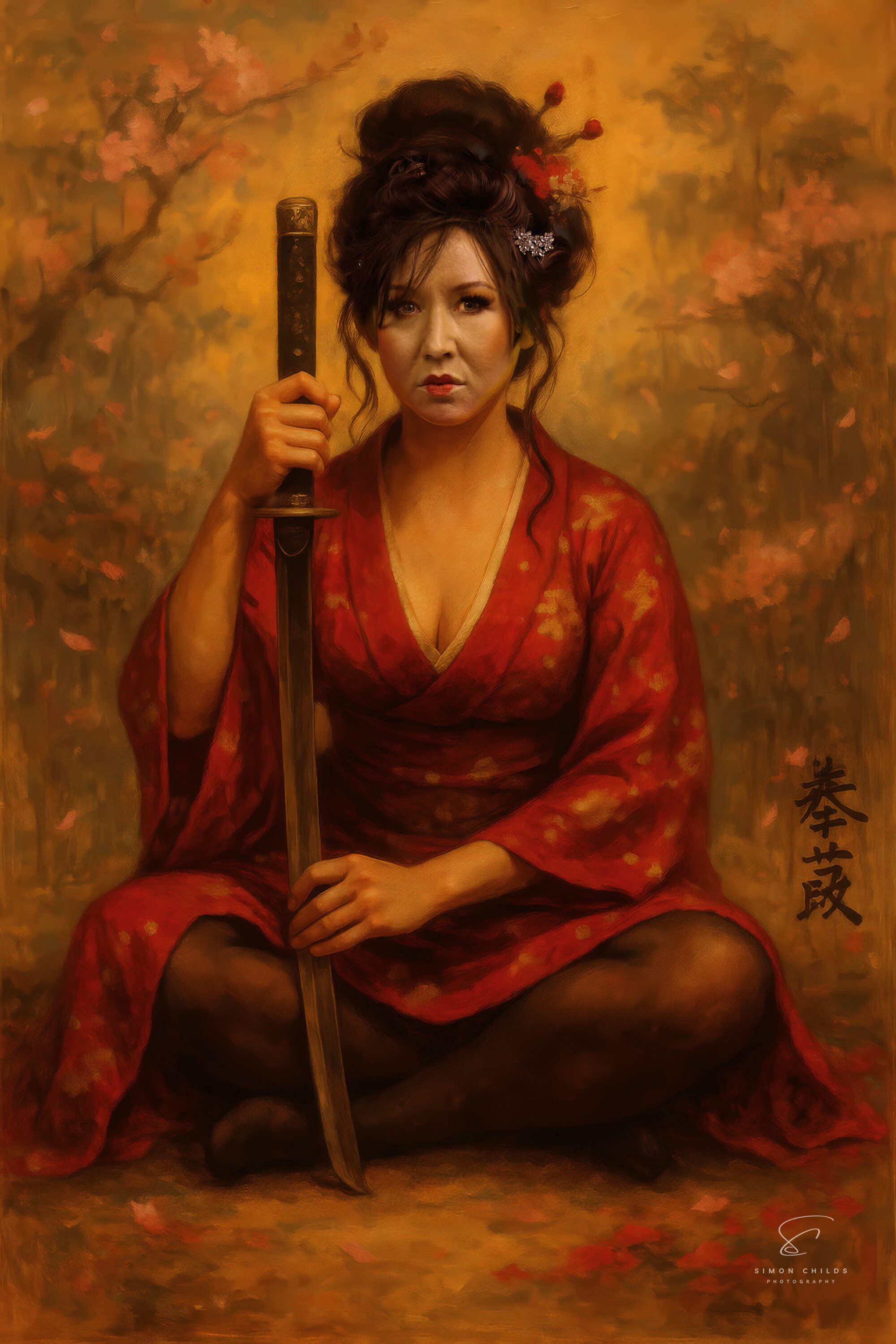
Blossom and Blade: How I Crafted a Painterly Warrior Portrait with Luminar Neo
There’s something timeless about the image of a poised warrior — calm in spirit, yet powerful in presence. That was the essence I wanted to capture in this portrait of the stunning @HotThing21, taken just yesterday in the studio. Armed with a Sony A7R V, two Godox AD600 strobes, and a painter’s mindset, I set out to create not just a photograph, but a visual homage to quiet strength — a modern portrait with the soul of a centuries-old oil painting.
The final result, enhanced in Luminar Neo, blends cinematic storytelling with classical artistry. Here’s the full journey from lens to layered brushstroke.
The Concept: Strength in Stillness
From the outset, I envisioned a portrait that merged tradition with contemporary edge — a fusion of samurai symbolism, painterly warmth, and feminine power. The katana, positioned vertically between her hands, would act as both centrepiece and metaphor: discipline, balance, inner clarity.
Inspired by the stillness of Renaissance portraiture and the bloom-heavy backgrounds of Japanese woodblock prints, I wanted the model to appear not aggressive, but grounded — strong not in motion, but in presence. Her gaze needed to hold the viewer, not challenge them. A silent invitation to witness, not judge.
The Studio Setup: Sculpting Light Like a Brushstroke
To bring this vision to life, I built a light setup designed to emulate natural, painterly falloff:
- Camera: Sony A7R V — its incredible resolution and tonal depth were essential for the fine skin detail and post-production flexibility I needed.
- Main Light: Godox AD600 fitted with a beauty dish just above and slightly forward of the subject, feathered for soft shadow transitions.
- Fill & Wrap: A second AD600 with a 6ft gridded octagonal softbox, placed at camera-left, added enveloping light that kissed the shadows without flattening them.
- Backdrop: A warm-toned textured backdrop with subtle floral overlays, evoking cherry blossoms — the fleeting beauty motif was deliberate.
The model sat cross-legged, shoulders relaxed, sword vertical and steady. I guided her into a controlled stillness, using breathwork and soft prompts to bring out a sense of composure and emotional depth.
Editing in Luminar Neo: From Realism to Rembrandt
Once in Luminar Neo, the transformation began — a careful journey from realism to refined artistry.
1. Base Corrections
I began by dialling in the essentials:
- Tweaked exposure and white balance for warmth
- Applied Skin AI and Face AI for subtle refinements — preserving natural texture while softening transitions
- Used Enhance AI sparingly to lift the midtones in the red kimono without losing depth
2. Establishing Painterly Mood
Next, I layered in mood:
- Mystical Tool added glow to the skin and background, subtly mimicking the light scatter of oil on canvas
- Color Harmony helped unify the warm tones — reds, oranges, and golds — into a cohesive, slightly desaturated palette
- Applied Glow on a soft mask to blur edges and simulate brush softness around the hair and sleeves
3. Creating the Painterly Effect
Here’s where Luminar Neo shines:
- I selectively reduced detail using Structure AI and masking, keeping only the eyes, blade, and lips crisp
- Added a canvas texture overlay using the Layers Panel, blended using the Soft Light mode
- Used Relight AI to enhance depth and bring subtle focus to her face while allowing the outer edges to fade
To finish the painterly illusion:
- I added Film Grain set to 20%
- Adjusted vignette with a centre shift just below her face
- Painted in digital shadows on the lower corners using a masked Dodge & Burn approach
Lessons Learned: Photography as Modern Mythmaking
This image reminded me of why painterly editing resonates — it allows you to step beyond technical reproduction and into emotional storytelling. When applied with intention, the painterly effect doesn’t obscure reality; it distils it.
Instead of chasing ultra-sharp hyperrealism, I leaned into softness, symbolism, and colour storytelling. Every brush-like effect had to earn its place — nothing gratuitous. The result? A portrait that feels timeless, symbolic, and deeply human.
If you’re attempting something similar, here’s my advice:
- Use light like a brush shape, and don’t just expose it.
- In post, commit to the painterly look — avoid leaving it halfway.
- Let your subject carry the emotion. The effects are there to amplify, not distract.
Closing Thoughts – Join the League!
This shoot was as much a meditation on storytelling as a technical exercise. The sword, stillness, and bloom all echo deeper themes of identity and quiet strength. Luminar Neo offered the perfect toolkit to realise that vision without spending hours in Photoshop.
If you’re experimenting with painterly effects in your portraits, I’d love to see them. Feel free to tag me or join the next Luminosity League session, where we’ll dive into practical walkthroughs of edits like this.
Until then, keep creating, refining, and letting your portraits speak louder than words.

